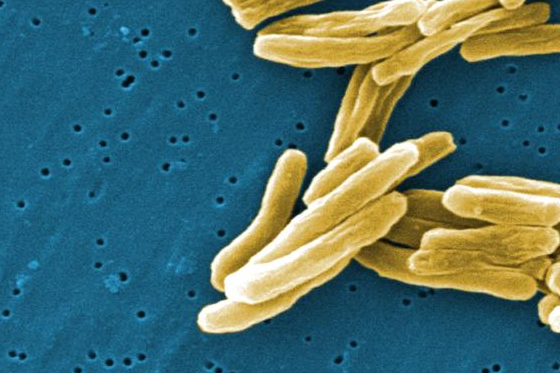
What is Tuberculosis?
Tuberculosis (TB) is a dreaded bacterial infection. It has been known to mankind since ancient ages. It was commonly called “consumption” at the turn of the last century because of the way the disease seemed to “consume” the individual it affected.
Causes and spread of the infection
The bacteria causing tuberculosis is called Mycobacterium tuberculosis. It is spread through inhaling tiny droplets from the coughs or sneezes of an infected person. Spread of tuberculosis is facilitated by several factors like overcrowding, living in close quarters like in orphanages, prisons etc. and presence of other medical problems.
Other medical problems that raise the risk of getting tuberculosis include malnutrition, alcoholism, presence of other infections like HIV infection that suppresses the immunity etc. Babies and the elderly are at a greater risk due to their ill-developed and declining immune system respectively.

Under a high magnification of 15549x, this colorized scanning electron micrograph (SEM) depicted some of the ultrastructural details seen in the cell wall configuration of a number of Gram-positive Mycobacterium tuberculosis bacteria. As an obligate aerobic organism M. tuberculosis can only survive in an environment containing oxygen. This bacterium ranges in length between 2 - 4 microns, and a width between 0.2 - 0.5 microns.
What is latent and active tuberculosis?
Getting the active disease means that the immune system fails to kill or contain the infection allowing it to spread to the lungs or other parts of the body. This is called active tuberculosis.
In some individuals the immune system cannot kill the bacteria, but manages to prevent it from spreading in the body. This can mean persistence of the bacteria in the body without producing symptoms. This is called latent tuberculosis.
When this is present, a decline of damage to the immune system may cause the infection to flare up to give rise to frank and active tuberculosis.
Symptoms and types of tuberculosis
Tuberculosis mainly affects the lungs where it is called pulmonary tuberculosis. It can affect any part of the body including bones, brain, womb or the uterus, skin, lymph nodes etc. or may spread widely to other organs as seen in miliary tuberculosis and disseminated tuberculosis.
Typical symptoms of pulmonary tuberculosis include:-
Typical symptoms of pulmonary tuberculosis include:-
- continued or a persistent cough of more than three weeks that brings up phlegm
- presence of streaks or drops of blood in the coughed up phlegm or sputum
- weight loss and fatigue and loss of appetite
- fever for a long duration that is not explained by any other cause
- night sweats
Diagnosis of tuberculosis
Tuberculosis is diagnosed using several laboratory techniques that test samples of blood and sputum. The bacteria can be found on staining and microscopic examination of the sputum.
More rapid and sophisticated blood tests are also available to test for tuberculosis. A chest X ray is used to visualize the tubercular lesions in the lungs. CT scan and MRI images may also be used for diagnosis.
For tuberculosis affecting lymph nodes, skin etc, the local lesion may be biopsied to detect tuberculosis bacteria.
Treatment of tuberculosis
With treatment, a TB infection can usually be cured. Treatment involves a course of antibiotics, usually for six months. More than one antibiotic is used to prevent emergence of resistance of the bacteria to the antibiotics. Those infected with a drug resistant form of tuberculosis may be prescribed a longer course of antibiotics.
Tuberculosis vaccine
The Bacillus Calmette-Guérin (BCG) vaccine can provide effective protection against tuberculosis in most individuals. It is recommended in persons who are at a greater risk of the infection. Infants living in countries endemic for tuberculosis are routinely vaccinated with BCG.
Tuberculosis epidemiology
TB was a major health problem in most of the developed countries like the UK before the development of antibiotics. The number of cases has declined sharply after routine detection and use of antibiotics. However, in the last two decades cases of tuberculosis have gradually increased, especially among ethnic minority communities and immigrant population.
In 2011, 8,963 cases of tuberculosis were reported in the UK (around 12 cases per 100,000 population). Of these nearly 6,000 cases were among population who were born outside the UK. There are many areas in the UK with much higher incidence rates, and those areas with incidence greater than 40/100,000. Pulmonary TB accounts for 60% of TB in the UK.
Tuberculosis is endemic in many developing and under-developed countries. Africa, particularly sub-Saharan Africa still suffers from a tuberculosis epidemic because of the increased susceptibility of the population due to concomitant HIV infection.
Sources
- http://www.nhs.uk/conditions/Tuberculosis/Pages/Introduction.aspx
- www.bbc.co.uk/health/physical_health/conditions/tuberculosis1.shtml
- http://www.ncbi.nlm.nih.gov/pubmedhealth/PMH0001141/
- http://www.who.int/tb/publications/tb_global_facts_sep05_en.pdf
- http://www.cdc.gov/tb/education/corecurr/pdf/chapter2.pdf
Further Reading
Last Updated: Aug 23, 2018






















.jpg)










No hay comentarios:
Publicar un comentario